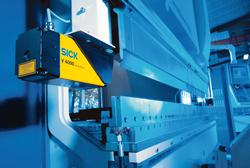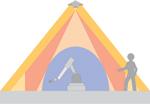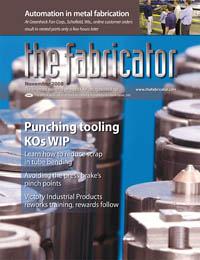Senior Editor
- FMA
- The Fabricator
- FABTECH
- Canadian Metalworking
Categories
- Additive Manufacturing
- Aluminum Welding
- Arc Welding
- Assembly and Joining
- Automation and Robotics
- Bending and Forming
- Consumables
- Cutting and Weld Prep
- Electric Vehicles
- En Español
- Finishing
- Hydroforming
- Laser Cutting
- Laser Welding
- Machining
- Manufacturing Software
- Materials Handling
- Metals/Materials
- Oxyfuel Cutting
- Plasma Cutting
- Power Tools
- Punching and Other Holemaking
- Roll Forming
- Safety
- Sawing
- Shearing
- Shop Management
- Testing and Measuring
- Tube and Pipe Fabrication
- Tube and Pipe Production
- Waterjet Cutting
Industry Directory
Webcasts
Podcasts
FAB 40
Advertise
Subscribe
Account Login
Search
Getting close, bending safe
Optoelectronic guarding allows brake operators to bend safely close to the punch
- By Tim Heston
- November 25, 2008
- Article
- Bending and Forming

Figure 1 Lasers that travel with the ram allow operators to bend small parts without muting the safety system. Photo courtesy of Fiessler Elektronik/Advanced Manufacturing Solutions.
Press brake operators work under some unique conditions. They move their fingers close to the point of operation, where the machine exerts tons of force that could easily crush a limb. And they do it all while under pressure to produce more parts in less time.
Not only do operators work close to pinch points, they also may perform a variety of work. "Press brakes are still used to perform bending and flattening with standard tooling for most applications, but now we see press brakes being used for more operations, including punching, trimming, cutoffs, special offsets, hemming, and sometimes all in one stroke of the machine," said Christopher King, LazerSafe product manager for OMRON Scientific Technologies Inc. (STI), Fremont, Calif. "A lot of people are buying new hydraulic press brakes and using them to replace other, secondary operations."
As Steve Aamodt, machine tool market manager for Minneapolis-based SICK Inc. put it, "There are so many different types of applications press brakes do. Developing a device that covers operators in every instance—that's the challenge."
Ed Zidek, product manager at MC Machinery Systems Inc., Wood Dale, Ill., brought up another point: "It's one of the few machines in which the operator actually handles and manipulates the part during the fundamental operation of the machine." With most machines, the operator moves while the part stays stationary.
Operator restraints, harnesses, and pullbacks can slow the operator significantly and can bring up additional challenges; operators can become entangled and lose control of the part, for example. And two-handed controls just aren't practical if the operator needs his hands free to handle the part. So for years many have opted for other electronic options. In this arena, light curtains, which emit beams of infrared light in front of the work area, have dominated the market. Today they remain a good option for certain press brake applications, including those with wide specialty tools performing some unusual operations, such as a punching die set. But light curtains do not fare so well for smaller parts, and they are often misadjusted for parts with large side flanges. Safety distance requirements mean the light curtain must be installed many inches away from the pinch point, a number that varies depending on the reaction time of the machine. To bend small parts, an operator may have to wait for the tooling to close to a ¼-in. opening or less, insert the part, and then temporarily bypass the light curtain so the brake can run.
"For standard equipment, normally you find a minimum safety distance of 4 inches," said Götz Fiessler, president of Fiessler Elektronik, a German company. "But often this isn't possible on the press brake because, again, the operator has to support the workpiece."
Operators also can be forced to mute large portions of the curtain to bend large parts, including box bends. "To make a box, operators can use a light curtain only if they blank [mute] out a big part of the safety field," Fiessler said. "But this, of course, makes it unsafe."
Unique operations call for unique safeguarding, said sources, and to that end technology has emerged this decade that takes the press brake's idiosyncrasies into account. This includes optoelectronic guarding that travels with the ram, which has changed matters for the better, according to sources (all of whom work with both light curtains and traveling systems). Some versions use a laser, others use a camera (see Figures 1 and 2), but all mount on each side of the ram and work on the same basic premise: Follow the ram motion and signal the machine to stop when that motion becomes a safety hazard.
Traveling With the Hazard
MC Machinery's Zidek recited a short history of brake safeguarding. "Operators have had restraining systems that pull their arms away as the ram comes down. Then we put light curtains on, to keep you far enough away so you can't reach in there, and in both of those cases the restraint of it has reduced productivity significantly. But now we're moving into laser and vision systems that allow people to work closer to the machine, work with smaller parts, and still maintain a reasonable level of safety.
"Most important," he said, "operators tend to use these because they press a button, and [the system] takes care of itself. When they have to spend time adjusting safety devices, it takes away from their productivity, and it makes them look bad. They want to meet the process time that's on the job router."

Figure 2 Traveling systems, like this camera-based safeguard, can sense areas of the working zone that will include part elements, such as flanges, and automatically mute them. Photo courtesy of SICK Inc.
The systems do require occasional adjustment, but nothing incredibly time-consuming. As the punch height changes, so does the position of these safety systems, so adjustments may be needed after a tool change. But these happen quickly, usually with some tool-change brackets with linear bearings. It may also be automated, with an operator pushing a button to move the traveling safeguard to the new position.
Traveling systems vary, but in general they feature beams that travel in front of the hazard zone, directly beneath the punch and die, and behind it toward the backgauge. And they can be set up to mute certain portions of the beam automatically. Consider that box bend again. If after two bends the operator positions the flanges to the side of or behind the tooling, the systems will mute the appropriate areas while keeping other areas active. The result is that safeguarding continues throughout the brake cycle, regardless of the part geometry.
The devices can be tied into the press control, Aamodt said, through a safety relay or to a safety controller built into the press brake. "In this case, the press can tell the safety device what jobs are coming up and what kind of bends there will be." (He added, though, that such control integration is "most often done on the OEM side rather than for a retrofit.")
Such safeguarding does require continual machine monitoring "to ensure safe stopping every cycle," STI's King said, explaining that certain traveling systems continually monitor stopping performance. If machines haven't been maintained properly—for instance, gibs aren't tightened to spec—"their stop time increases, meaning that the safety distance requirement changes." If the stopping distance grows sufficiently, he said, the system stops the brake (see Figure 3). "It's controlling the hazardous motion regardless of where the stroke is in the machine," King explained.
Not a Panacea
The traveling systems aren't ideal for all applications. King, for instance, said the systems safeguard with laser beams or a camera covering just behind and in front of the punch and die. "If you use a 4-inch flattening die or a 6-inch radius die, the laser beam or camera may not be wide enough to protect the operator from the pinch point."
Another issue comes up when a machine setup is staged with punches of varying heights. The traveling systems align with one punch height. But say a 2-in. punch is next to a 5-in. punch. In this example, the tools would descend, and the traveling system, aligned with the 2-in. punch, would mute as that shorter punch closes. "With this example, there is a 3-inch gap there where somebody could reach into that tool during the hazardous portion of the stroke," King said. To use any traveling system in this setup, "you need to have a common passline height across the punches for the entire machine."
He added that shops that run a lot of these specialized setups might guard a brake with both a light curtain and a laser system, with the operator being able to switch between the two. Between two safeguards, operators should be able to run every job.
"Many realize that there is not one safeguard that will fit all applications," King added.
Older brakes can cause issues as well. The traveling systems sit right under the punch, so a machine must be able to react quickly from a signal. "Some press brakes, such as mechanical friction-clutch machines, by design just cannot stop fast enough to use close-proximity safeguarding," King said.
A brake's stopping distance must meet certain requirements. "The ram has to be able to stop over a certain short distance from full speed in order for these [traveling systems] to work," Aamodt said. "For our camera system, we generally need the ram to stop within 11 mm [depending on the machine]. This is from the time there's an intrusion into the safety field, back through the safety device, into the safety relay, and into the press control to stop the ram."
Moreover, sources emphasized that integrating a safeguard, be it a traveling system, light curtain, or otherwise, does not automatically make a press brake safe. OSHA looks at a brake's safety holistically and, according to Aamodt, companies should do the same.
"Light curtains and traveling systems are just one part of safeguarding," he said. "You have to worry about the rest of the brake: the foot pedal, the valves, and the control. Older press controls may not have dual-channel, or redundant, electronics, so upgrading the safety control is important to bring the machine up to current standards."
The Safety-Productivity Dichotomy
Sources conceded that safeguarding devices may slow cycle times, but the latest safeguards at least minimize the slowdowns—a small price to pay to prevent worker injury and the lawsuits that may come with it. A laser-guarded brake, for instance, can run at about 90 percent productivity of a brake running full out with no guarding, King said.
He added that when analyzing productivity of safeguards, shops should ensure they're making comparisons between devices that are properly applied, or risk creating a false sense of security. A safeguarding device that's never on, improperly used, or misadjusted will probably win the cycle time test every time.
How safe is the operator's finger? Well, that's another story.
Here’s Looking at You
A recent university project demonstrated some interesting interaction between robots and humans. If a person were a sufficient distance away, the robot would move at full speed. If the person moved closer, the robot slowed down; if that person moved even closer, the robot stopped entirely.
The operation was monitored by a camera-based vision system. Parked unobtrusively above the operation, the camera could "see" the operation in three dimensions. "These vision systems have sensing zones in horizontal and vertical planes," said Lee Burk, training coordinator at Pilz Automation Safety in Canton, Mich. "With this system you are free to move anywhere outside the warning area, and the robot can move at high speed."
Such vision systems, like the one Pilz introduced to the market last year, have big potential in the safety arena, Burk said, the most imminent being simplifying safeguarding requirements. A robotic press brake cell alone may have some hard guarding and some gate interlocks. Marry this with a larger, automated setup, and safeguarding may include everything from laser scanners and hard guarding to light curtains.
A single vision system, Burk said, could replace them all.
About the Author

Tim Heston
2135 Point Blvd
Elgin, IL 60123
815-381-1314
Tim Heston, The Fabricator's senior editor, has covered the metal fabrication industry since 1998, starting his career at the American Welding Society's Welding Journal. Since then he has covered the full range of metal fabrication processes, from stamping, bending, and cutting to grinding and polishing. He joined The Fabricator's staff in October 2007.
subscribe now

The Fabricator is North America's leading magazine for the metal forming and fabricating industry. The magazine delivers the news, technical articles, and case histories that enable fabricators to do their jobs more efficiently. The Fabricator has served the industry since 1970.
start your free subscription- Stay connected from anywhere

Easily access valuable industry resources now with full access to the digital edition of The Fabricator.

Easily access valuable industry resources now with full access to the digital edition of The Welder.

Easily access valuable industry resources now with full access to the digital edition of The Tube and Pipe Journal.
- Podcasting
- Podcast:
- The Fabricator Podcast
- Published:
- 04/16/2024
- Running Time:
- 63:29
In this episode of The Fabricator Podcast, Caleb Chamberlain, co-founder and CEO of OSH Cut, discusses his company’s...
- Trending Articles
AI, machine learning, and the future of metal fabrication

Employee ownership: The best way to ensure engagement

Dynamic Metal blossoms with each passing year

Steel industry reacts to Nucor’s new weekly published HRC price

Metal fabrication management: A guide for new supervisors

- Industry Events
16th Annual Safety Conference
- April 30 - May 1, 2024
- Elgin,
Pipe and Tube Conference
- May 21 - 22, 2024
- Omaha, NE
World-Class Roll Forming Workshop
- June 5 - 6, 2024
- Louisville, KY
Advanced Laser Application Workshop
- June 25 - 27, 2024
- Novi, MI



























